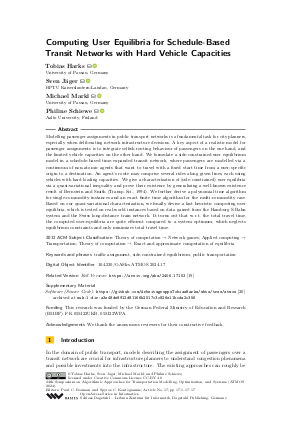OASIcs.ATMOS.2024.17.pdf
- Filesize: 0.92 MB
- 17 pages

 Creative Commons Attribution 4.0 International license
Creative Commons Attribution 4.0 International license

Modelling passenger assignments in public transport networks is a fundamental task for city planners, especially when deliberating network infrastructure decisions. A key aspect of a realistic model for passenger assignments is to integrate selfish routing behaviour of passengers on the one hand, and the limited vehicle capacities on the other hand. We formulate a side-constrained user equilibrium model in a schedule-based time-expanded transit network, where passengers are modelled via a continuum of non-atomic agents that want to travel with a fixed start time from a user-specific origin to a destination. An agent’s route may comprise several rides along given lines, each using vehicles with hard loading capacities. We give a characterization of (side-constrained) user equilibria via a quasi-variational inequality and prove their existence by generalizing a well-known existence result of Bernstein and Smith (Transp. Sci., 1994). We further derive a polynomial time algorithm for single-commodity instances and an exact finite time algorithm for the multi-commodity case. Based on our quasi-variational characterization, we finally devise a fast heuristic computing user equilibria, which is tested on real-world instances based on data gained from the Hamburg S-Bahn system and the Swiss long-distance train network. It turns out that w.r.t. the total travel time, the computed user-equilibria are quite efficient compared to a system optimum, which neglects equilibrium constraints and only minimizes total travel time.


Feedback for Dagstuhl Publishing